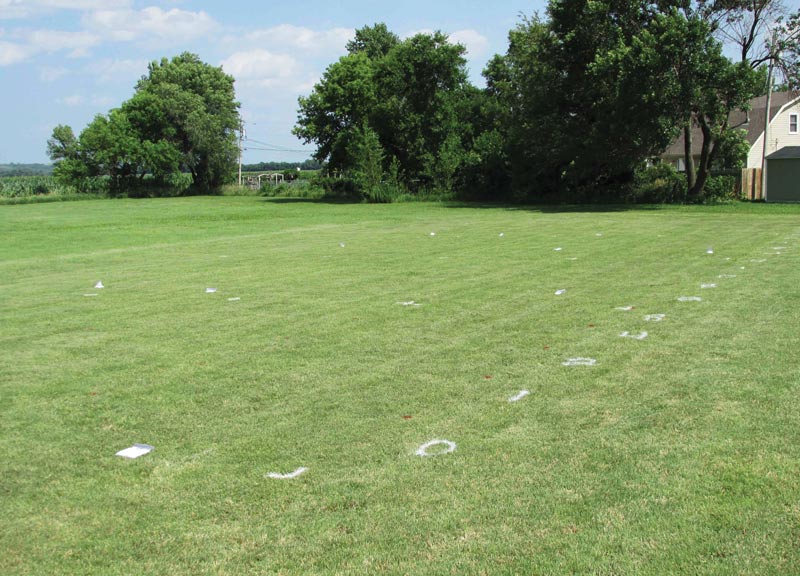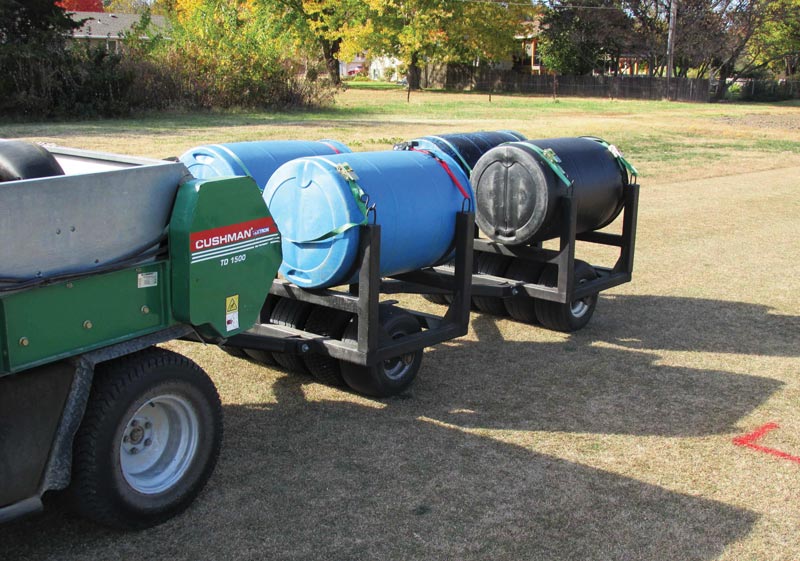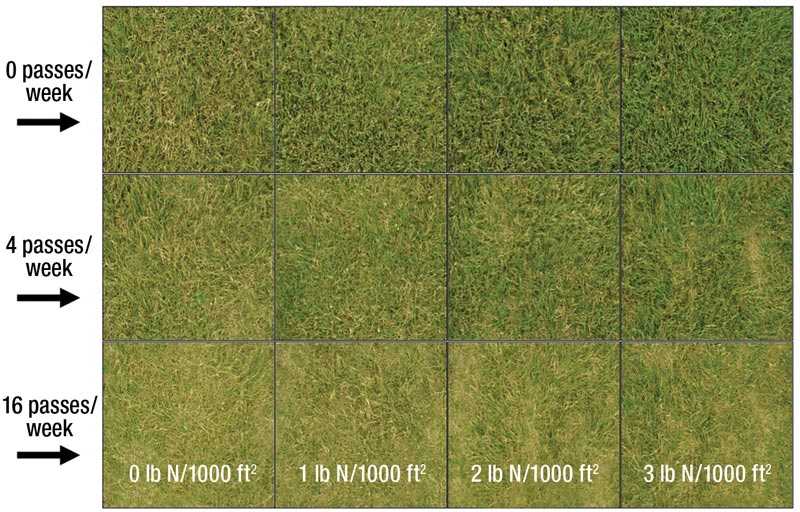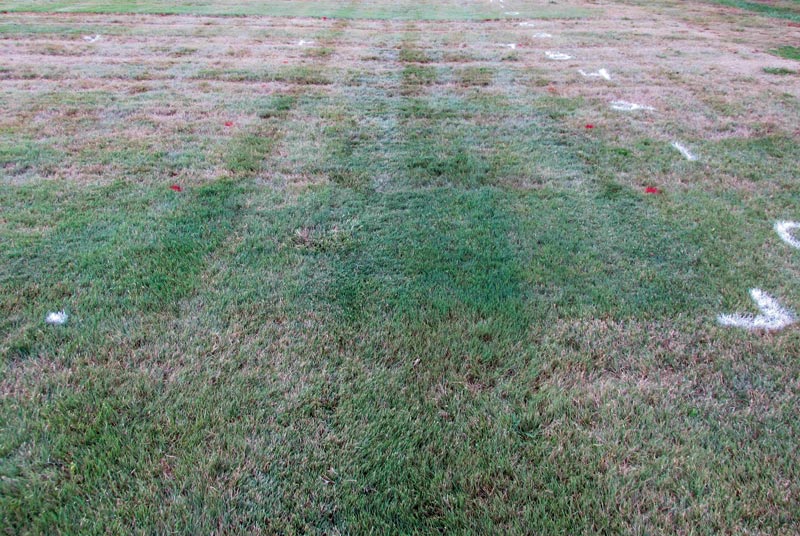
Figure 1. The buffalograss nitrogen and traffic research area before the study began at the Rocky Ford Turfgrass Research Center in Manhattan, Kan., in 2014. Photos by Evan Alderman
In recent years, many golf courses in the United States transition zone have experienced drought or drought-like conditions. Let’s be honest: Turf managers in the transition zone never know what Mother Nature is going to throw at them from year to year. These uncertain conditions and the overall awareness of water consumption on golf courses have forced many golf course superintendents to evaluate alternatives for low-maintenance areas on their courses.
With an average of 34 irrigated acres (13.75 hectares) of rough for each U.S. golf course, using a low-input turfgrass species like buffalograss (Buchloe dactyloides [Nutt.] Engelm. synonym Bouteloua dactyloides [Nutt.] Columbus) has the potential to reduce water consumption without affecting appearance or playability (7).
Environmental damage to turf is a significant factor in golf course management, but superintendents also need to consider damage resulting from daily play. Golf cart traffic to access rough areas on the course can cause serious plant injury by directly damaging turfgrass leaves, and it can also influence plant growth through soil compaction (3).
Although compaction issues have typically been reduced by aerification practices, applying moderate levels of nitrogen fertility has been viewed as a way to alleviate wear on the turf caused by the abrasive force of golf cart tires. Previous research has shown that applying nitrogen fertilizers to creeping bentgrass (Agrostis stolonifera L.) and Kentucky bluegrass (Poa pratensis L.) increased its resistance to damages caused by wear (5).
Acceptable stands of buffalograss have been achieved by applying moderate levels of nitrogen fertility. In a three-year study in Nebraska, Kansas and Utah, researchers reported that Cody buffalograss treated with urea at 2 or 4 pounds nitrogen/1,000 square feet/year (97.6 or 195.29 kilograms/hectare) had better-than-acceptable quality, color and growth compared with Cody buffalograss treated with lower nitrogen application rates and with no applied traffic (6).
Other researchers have reported that common buffalograss or early cultivars may be intolerant to traffic. However, there is variation in response among cultivars, and some cultivars are tolerant of traffic (2). Variation in the ability of buffalograss to withstand traffic damages could be associated with its fine leaf texture and slow growth characteristics. Previous research showed that under drought conditions and with or without traffic, buffalograss maintained higher turfgrass quality at fairway and rough mowing heights than Kentucky bluegrass (Poa pratensis) and tall fescue (Schedonorus arundinaceus [Shreb.]) (4).
Minimal information is available on the traffic tolerance of buffalograss under varying nitrogen fertility management programs. The goal of this study was to determine whether differences in nitrogen fertility levels influenced the traffic tolerance of Cody buffalograss.
The experiment
We conducted a two-year field study that consisted of three separate studies at the Rocky Ford Turfgrass Research Center in Manhattan, Kan., from 2014 to 2015. These studies were conducted on mature Cody buffalograss that had received no fertility, pesticides or supplemental irrigation in the previous five years. Our experiment included 16 whole plots and 20 strip plots arranged in a 4 (nitrogen fertility) by 5 (traffic) treatment factorial in a strip-plot design with four replications (Figure 1, above).
To simulate a low-maintenance golf course rough environment, the buffalograss was mowed twice per week with a rotary zero-turn mower, and supplemental irrigation of 2 inches (5.08 centimeters) was applied only to water-in fertility treatments.
Nitrogen treatments during the study were applied with urea at 0, 1, 2 and 3 pounds nitrogen/1,000 square feet/year (48.8, 97.6 and 146.4 kilograms/hectare). Over the 14-week experimental period, nitrogen applications were split into two half-rate applications, with applications occurring at the beginning of the trial and then again eight weeks after the initial nitrogen application. After both nitrogen applications, the fertilizer was immediately watered-in with 0.25 inch (0.635 centimeter) of irrigation.

Figure 2. The traffic simulator used throughout the study consisted of two 1,000-pound trailers, each with a single axle and five golf cart tires.
Simulated golf cart traffic treatments were run twice per week for the duration of the experiment, with weekly passes totaling zero, two, four, eight and 16 passes/week. The traffic simulator consisted of two trailers, each weighing 1,000 pounds (453.59 kilograms) and supported by a solid axle and five golf cart tires (Figure 2) (2, 8). At certain times during the experiment, two rollers weighing 390 pounds (176.9 kilograms) each were pulled in tandem because of mechanical issues with the original traffic simulator. When in use, both simulators were pulled in straight lines with no turning, which we deemed was similar to the traffic imposed on the turf near where golf carts enter or exit cart paths.
Percent green color measurements were taken every two weeks throughout the 14-week study period. Images were taken with a camera light box and then analyzed using a software program to determine the percent of green pixels in the image (0% to 100% scale). Additional ratings of visual turf color (0 to 9 scale, 6 = acceptable color), visual turf quality (0 to 9 scale, 6 = acceptable color), soil penetration resistance and soil volumetric content were also collected.
Nitrogen rate effect on buffalograss green cover, quality and color
Through data analysis, we found that the interaction between nitrogen rate and traffic rate was not significant. Therefore, nitrogen rate and traffic rate will be discussed separately here.
We observed that when higher rates of nitrogen were applied, Cody buffalograss typically had better-than-acceptable percent green cover and visual quality regardless of traffic rate (Table 1).

Figure 3. Light box images taken 10 weeks after study initiation comparing differing traffic levels and nitrogen application rates.
During the first half of the study, we observed that applying 2 or 3 pounds nitrogen/1,000 square feet/year produced higher percent green cover than when 0 or 1 pound nitrogen/1,000 square feet/year was applied. However, for the majority of the study period, any nitrogen application rate resulted in higher percent green cover than no nitrogen application, regardless of traffic rate (1). Similar results were observed for visual quality and color. When no nitrogen was applied, the buffalograss never achieved acceptable visual quality or color, regardless of traffic level (Figure 3).
Effect of traffic rate on buffalograss green cover, quality and color
We observed that when higher levels of traffic were applied, percent green cover, quality and color decreased over time. After the initial rating period, buffalograss receiving 16 passes of traffic per week had the lowest percent green cover and visual quality of all applied traffic treatments. This is similar to observations in an earlier study on buffalograss, where 16 passes/week of traffic reduced percent green cover to around 40% to 50% (4). However, in that same study, it was also noted that the buffalograss quickly recovered (to approximately 75% green cover) after traffic stopped.
Better-than-acceptable visual quality (>6) was observed for 12 weeks of the study period when no traffic was applied. However, buffalograss receiving two and four passes of traffic per week showed acceptable quality for around eight to 10 weeks.

Figure 4. Differences in buffalograss turf quality and color were quite evident after 14 weeks of traffic applications.
When any traffic is applied to a turf area, discoloration can occur from wear and abrasive forces on the leaf blades, ultimately affecting turfgrass quality (Figure 4). When we applied zero to four passes of traffic per week, we saw the buffalograss sustain eight to 14 weeks of acceptable (>6 rating) green color.
What does this all mean?
Although buffalograss may not make sense for every situation, many low-input turfgrass management systems could benefit greatly from using buffalograss. More research is needed to assess the viability of newer buffalograss cultivars, but we believe our research shows that buffalograss can be an effective low-input option.
Buffalograss is often considered a no-maintenance turfgrass species, but this research shows that a little maintenance can improve the success of buffalograss on golf courses. In our research, the green cover, quality and color of buffalograss that received 1 to 3 pounds nitrogen/1,000 square feet/year was superior to that of buffalograss that received no nitrogen (with and without traffic). In certain situations, applying moderate levels of nitrogen fertility can increase the resistance of buffalograss to traffic stress. However, high levels of traffic greatly affected the percent green cover, quality and color of buffalograss.
It is highly recommended that superintendents who manage buffalograss pay special attention to traffic areas near the entrances and exits of cart paths. To ensure that the buffalograss stand is not injured to the point of no return, altering traffic patterns with ropes and stakes may be advisable in high-traffic areas.
Buffalograss is a great option to help reduce management inputs and water consumption. Its ability to withstand many environmental conditions while maintaining playability and aesthetic appeal may be beneficial in low-input turf areas.
Funding
The authors would like to thank the Kansas Turfgrass Foundation for funding this research.
Acknowledgments
Thanks are extended to Cliff Dipman for technical support and expertise.
The research says ...
- The goal of this study was to determine the effects of nitrogen fertility levels on traffic tolerance of Cody buffalograss on golf courses.
- Cody buffalograss treated with 1 to 3 pounds of nitrogen/1,000 square feet/year produced green cover, quality and color superior to that of turf that received no nitrogen.
- In some situations, moderate fertility levels can increase buffalograss resistance to traffic stress, but superintendents should also reduce traffic stress by altering traffic patterns when needed.
Literature cited
- Alderman, E.J., J.A. Hoyle, J.A. Reeves and R.C. Braun. 2018. Evaluating the effects of nitrogen rate and simulated golf cart traffic on ‘Cody’ buffalograss roughs. Crop, Forage & Turfgrass Management 3. doi:10.2134/cftm2018.09.0079
- Amundsen, K., L. Li, R.C. Shearman and R.E. Gaussoin. 2017. Addressing misperceptions regarding buffalograss tolerance to sandy soils, traffic, and shade. International Turfgrass Society Research Journal 13:358-363. doi:10.2134/itsrj2016.05.0347
- Beard, J.B. 1973. Turfgrass: Science and culture. Prentice Hall, Englewood Cliffs, N.J.
- Braun, R.C. 2017. Environmental and management impacts in turfgrass systems: nitrous oxide emissions, carbon sequestration, and drought and traffic stress. Ph.D. dissertation. Kansas State University, Manhattan, Kan.
- Carroll, M.J., and A.M. Petrovic. 1991. Wear tolerance of Kentucky bluegrass and creeping bentgrass following nitrogen and potassium application. HortScience 26:851-853.
- Frank, K.W., R.E. Gaussoin, T.P. Riordan, R.C. Shearman, J.D. Fry, E.D. Miltner and P.G. Johnson. 2004. Nitrogen rate and mowing height effects on turf-type buffalograss. Crop Science 44:1615-1621.
- Throssell, C.S., G.T. Lyman, M.E. Johnson, G.A. Stacey and C.D. Brown. 2009. Golf course environmental profile measures water use, source, cost, quality, and management and conservation strategies. Applied Turfgrass Science 6. doi:10.1094/ATS-2009-0129-01-RS
- Watkins, E., A.B. Hollman and B.P. Horgan. 2010. Evaluation of alternative turfgrass species for low-input golf course fairways. HortScience 45:113-118.
Evan J. Alderman is an Extension specialist for the Pesticide Safety Education Program at Iowa State University, Ames, Iowa; Jared A. Hoyle is an assistant professor, Extension turfgrass specialist and director of the Rocky Ford Turfgrass Research Center at Kansas State University, Manhattan, Kan.; Jacob A. Reeves is a graduate student in the Department of Horticulture and Natural Resources at Kansas State University, Manhattan, Kan.; and Ross C. Braun is a postdoctoral research associate in turfgrass science at Purdue University, West Lafayette, Ind.